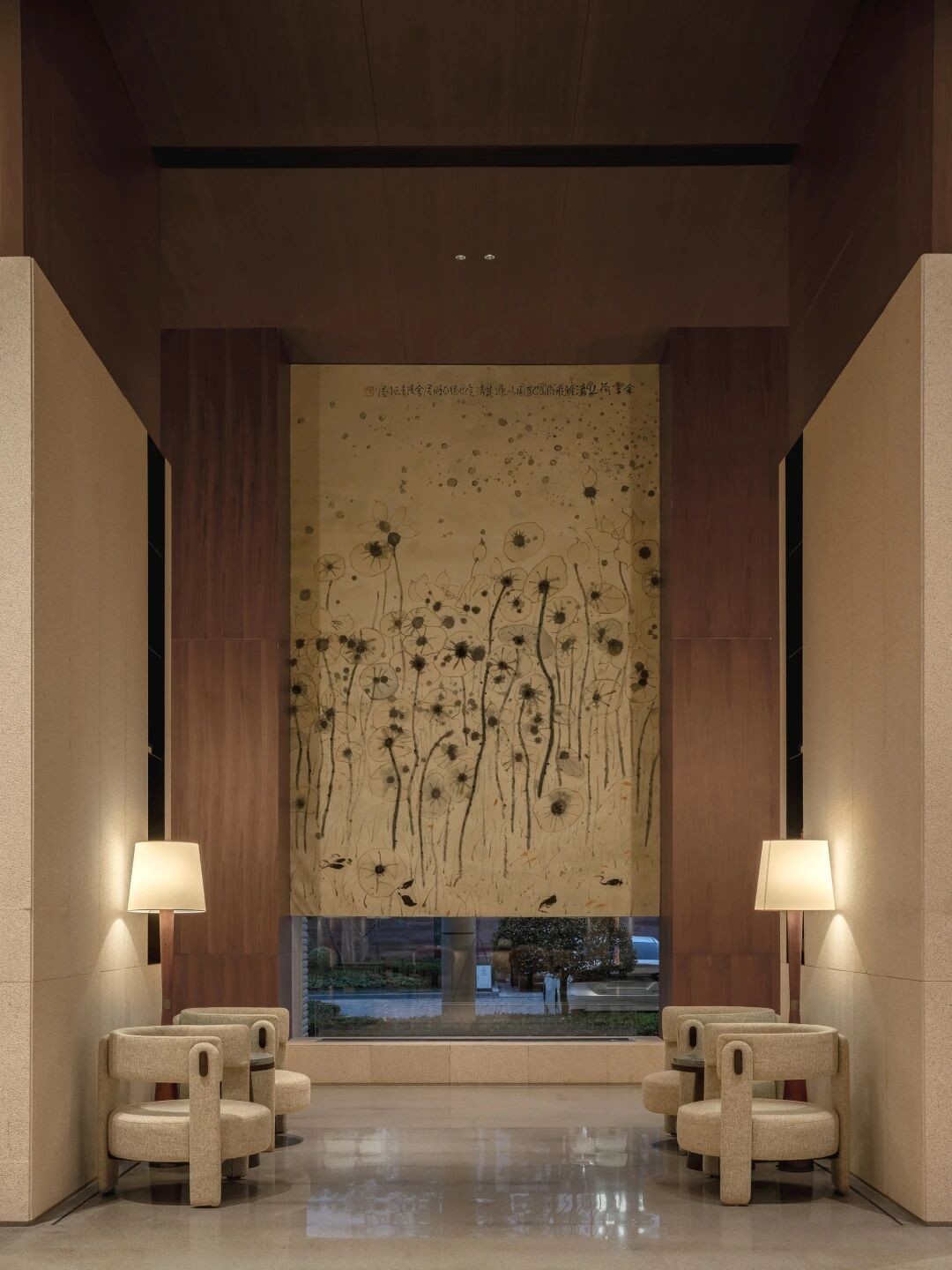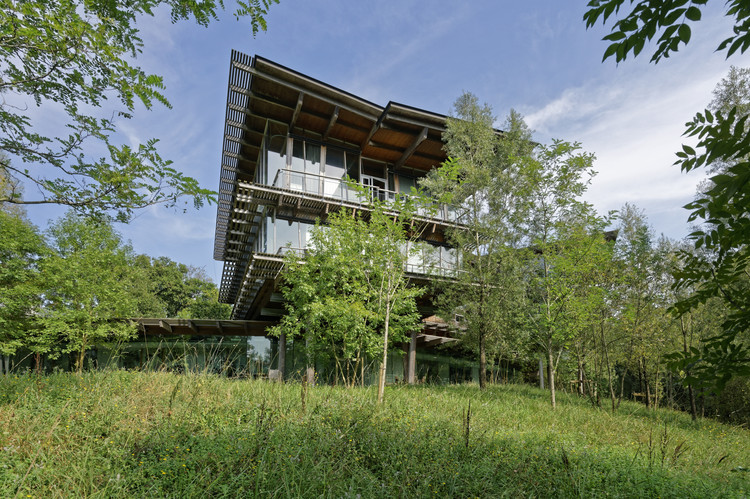Green Cascade Atelier de la Passerelle
2014-06-29 01:00
架构师提供的文本描述。该计划包括里昂第三区一个4,000平方米大土地上的100个住房单元。它位于城郊式街区的北部,其特点是各种不同的建筑方案、形式、聚集和建造日期。该项目取代了被拆除的前凯勒-多里安工厂(建于1895年、1928年和1960年,分三个阶段),该工厂生产用于金属雕刻的小型金属物品,特别是用于纺织印刷所需的卷筒。
Text description provided by the architects. The scheme comprises 100 housing units on a large 4,000 m2 site in Lyon’s 3rd arrondissement district. It occupies the northern part of an inner suburb-type block, characterised by various architecture of different programmes, forms, massing, and construction dates. The project takes the place of the demolished former Keller-Dorian factory (built in three stages, in 1895, 1928 and 1960), which produced small metal items for engraving on metal, particularly for the rolls required in textile printing.
在遵守城市规划规例的情况下,该计划建议对市区的街区作出新的解释。该计划以交替的固体和空隙,成功地维持街道正面,同时又保留一个由一边至另一边的可见、环境美化的内院。这个大方案是由五座小建筑物组成的,建在一个分层的花园里。简单、统一的建筑与外部空间的柔和、和谐的氛围是一致的。
Observing urban planning regulations, the scheme proposes a new interpretation of the urban block, which, with alternating solids and voids, succeeds in maintaining street frontage while preserving a visible, landscaped inner court that runs through from one side to the other. This large scheme is made up of five small buildings placed in a tiered garden. The simple, unified architecture is in keeping with the soft, harmonious atmosphere of the external spaces.
客户说的话:Nicolas Ducrohet,项目主任
What the client says: Nicolas Ducrohet, Programmes Director
Cogedim Grand Lyon每年建造大约450座房屋。绿色级联是一个相对较大的方案。20套公寓供hmf社会住房机构使用,2套公寓保留给人居中心。
Cogedim Grand Lyon builds around 450 homes every year. Green Cascade is a relatively large scheme. 20 apartments are for the HMF social housing agency, 2 are reserved for Habitat & Humanisme, and the remaining 78 are sold to private individuals. The scheme consists mainly of small housing units, which is a general trend in the city centre. “Construction work was completed very rapidly for the first-rate redevelopment of a polluted industrial site with high-quality homes. The architects succeeded in exploiting regulations concerning both urban planning (“URM” zone) and architecture (set-back penthouses). Everything was done to create a living environment that meets the criteria of modern comfort: the human scale of the buildings, their aspects, the balance with the garden, the housing unit modules, and the very adaptable large sunny balconies.”
1 - Urban street frontage, landscaped inner court
“大里昂地区地方城市发展计划”界定的关于“URM”区的条例提出了一项基于对城市街区的全新概念的城市形态原则。传统的城市街区是封闭的,连续的立面创造了一个线形的街道前,同时解放了一个开放的中央内部空间,与街道隔绝。另一方面,“URM”区的原则是以施工与空隙交替为基础的。它保持了一个城市中心街道的正面与框架,突出的意见,在一个美化的内院空间。两种特色的氛围相互回应和互补:街道边的城市,以及内部庭院空间的美化。光线穿过整个建筑厚度,为每个小块提供采光。“URM”地带条例的另一个具体特点是允许在中央空间内建筑。
Regulations concerning the “URM” zone, defined by the Local Urban Development Plan for the Greater Lyon area, suggests a principle of an urban form based on an entirely renewed conception of the urban block. The traditional urban block is closed, with continuous façades that create a linear street front while freeing an open central inner space, cut off from the street. On the other hand, the principle of the “URM” zone is based on the alternation of construction and voids. It maintains a city centre street front together with framed, highlighted views onto a landscaped inner court space. Two characteristic atmospheres respond to and complement each other: urban on the street side, and landscaped in the inner court space. Light passes through the entire constructed thickness, providing daylighting of each small block. The other specific characteristic of the “URM” zone regulations is that they allow building within the central space.
该计划由五座小街区组成,其中四座位于三条街道(安托万·查利街、圣·埃塞贝街和莱斯佩街),另一栋低矮的建筑在中央花园区没有顶层公寓。由于东西向水平(4m)的显著差异,包括一个桥墩和一个梯级梯田花园。
The scheme is made up of five small blocks, four of which are on the three streets (Rue Antoine Charial, Rue Saint Eusèbe and Rue de l’Espérance), and one low building without penthouses in the central garden area. A plinth and a garden with tiered terraces were included due to a significant difference of level (4m) between east and west.
Rapha l自1985年以来一直住在149号公路上。149号就在D楼入口处的上方,该大楼位于查利街和埃斯佩雷斯街的拐角处。他见证了凯勒-多里安第一部分的拆除和对面八层建筑的建造。他回答了我的问题:“这是一个很好的变化!与其他地区相比,公寓楼仍然很低。这座城市建设得越来越好,但它仍保持着它的绿色植物。“他务实地补充道:“建筑工程进展顺利。它没有造成任何特别的不便,…而且施工质量似乎是非常可靠的!“
Raphaël has lived at 149 Rue Charial since 1985. No. 149 is just above the entrance to building D, which is on the corner of Rue Charial and Rue Espérance. He witnessed the demolition of the first part of the Keller-Dorian and the construction of the eight-storey building opposite. He answered my questions: “It’s a nice change! The apartment blocks remain very low in relation to the rest of the neighbourhood. The city is becoming more built-up, but it’s keeping its greenery.” Pragmatically, he added: “The building work went well. It didn’t cause any particular inconvenience… And the quality of construction appears to be very reliable!”
2 - Today’s apartment housing: a place for mixing
如今,公寓项目的基础是提供混合住房的原则,无论是在住房单位的范围上还是在社会结构上。住房单元分为五个地块。它们是根据白天和夜间空间的分离而设计的,总是喜欢双面的,包括一面朝南。它们由适应性强的大房间组成,还有大阳台。
Nowadays, apartment housing projects are based on the principle of providing mixed accommodation, in terms of both the range of housing units and the social mix. The housing units are divided among five plots. They are designed according to the separation of daytime and night-time spaces, always preferring a double aspect, including one side facing south. They are made up of easily adaptable large rooms, and they have large balconies.
Courtesy of Atelier de la Passerelle
Atelier de la Passerelle提供
虽然四幢面向街道的楼宇在面积上大致相同,但内庭范围内的楼宇则是以其他原则为基础的。它仅由单卧室公寓组成,可通过阳台和楼梯进入,由钢屋顶覆盖。这座三层楼高的建筑的外墙让人想起了阁楼,外面的表皮是由落叶松木制成的。尽管面积较小,但这些公寓也有大阳台,这是该方案的特色。
While the four buildings facing onto streets are more or less similar in terms of the range of sizes of their apartments, the building in the inner court area is based on other principles. It only consists of single-bedroom apartments, accessible via access balconies and stairs, covered by a steel roof. The façade of this three-storey building recalls that of the penthouses, with an external skin made up of larch battens. Despite their small size, the apartments also have large balconies, which are the scheme’s distinctive features.
在社会结构方面,大部分计划是为首次置业人士而设,包括为首次置业人士而设的一些资助房屋。A楼是租来的。根据当地城市发展计划,顶层公寓,即梦想中的屋顶-顶楼,是通过将顶层或顶上两层相对于主立面的方式建造的。它的优点是尽量减少建筑物的高度,从街道上看到,同时也可能隐藏服务工厂的屋顶和解放大的连续阳台。顶楼变成了屋顶上的真正的房子,有着令人眼花缭乱的景色。这套公寓由宽敞的阳台和铺在道具上的木条组成。他们舒适的2米宽使他们真正的户外休息室。
In terms of social mix, most of the scheme is designed for first-time buyers, including some subsidized homes for first-time buyers. Building A is for rented accommodation. In accordance with the Local Urban Development Plan, the penthouse, the dream roof-top home, is constructed by setting back the top floor or the top two floors in relation to the main facade. It has the advantage of minimising the building’s height as seen from the street, while also possibly concealing services plant on the roof and freeing large continuous balconies. The top floors become real houses on the roof, with commanding views. The apartments are extended by spacious balconies in timber slats laid on props. Their comfortable 2 m width makes them real outdoor lounges.
玛丽·简是查利街128号5楼一间小公寓的房客。“在美学上,我非常喜欢这些不同的建筑。街区之间的空隙让我想起了一座由花园隔开翅膀的老建筑。木材的完成与精致的花园很相配,那里种植的树木和植物在里昂是罕见的“。Léna住在C楼底层的一套两居室公寓里:“搬家了19次,我可以说这些公寓设计得很好。我们宽敞的阳台非常宜人,朝南,没有建筑物可以看到。大阴影窗户提供外部视图,同时保持内部非常凉爽。隔音有助于你在旧建筑里享受不到的舒适。“
Marie Jane is the tenant of a small apartment on the 5th floor of 128 Rue Charial. “Aesthetically, I liked these different buildings very much. The gaps between the blocks remind me of an old building with wings separated by gardens. The wood finish goes well with the refined garden, which is planted with trees and plants that are rare in Lyon”. Léna lives in a two-bedroom apartment on the ground floor of building C: “Having moved house nineteen times, I can say that these apartments are very well designed. Our spacious balcony is very pleasant, facing due south, with no buildings looking onto it. The large shaded windows provide external views while keeping the interior very cool. The sound insulation contributes to comfort that you don’t have in old buildings.”
3 - Playing with few effects
在这种情况下,建筑师选择了一个方案是谨慎和不炫耀。建筑风格和形式简单。“空间就是奢侈”是一个保证居住者舒适的概念。该方案使用的材料很少,但高质量的材料,精心应用,注重细节.
In this context, the architects opted for a scheme that is discreet and unostentatious. The architectural style and the forms are simple. “Space is luxury” is a concept that ensures the occupants’ comfort. The scheme uses few materials, but high-quality materials that are carefully applied with attention to detail.
这些建筑物由三层组成。首先,用树脂模具塑造垂直元素,使其具有动态视觉效果,并通过凹槽连接突出,形成染色和纹理模塑后的混凝土基座。水平基座承担水平的变化。第二,这个底层支撑着建筑物的主体,由两层简单的混凝土层组成。第三,这些楼面由一层或两层的顶层阁楼组成,其外墙是竖直放置的木条,因此有50%的空隙和50%的固体,以符合防火规定。在街道边,重复的210×240厘米的开口让人想起了以前工厂的风格。在内场方面,材料的选择和组合产生了微妙的图形效果。在膨胀的金属护栏、卧式太阳百叶窗、木立面和阳台上的木头之间形成了一系列的线条。
The buildings are composed of three strata. Firstly, a concrete plinth with a dyed and textured moulded finish is formed by a resin mould that shapes the vertical elements, giving it a dynamic visual effect, accentuated by a recessed joint. The horizontal plinth takes up the changes in level. Secondly, this ground floor supports the main body of the building, consisting of two floors of simply rendered concrete. Thirdly, these floors are topped by a single-storey or two-storey penthouse, whose external walls are covered with wooden battens placed vertically so that there are 50% voids and 50% solids, to comply with fire regulations. On the street side, the repetitive large 210 x 240 cm openings recall the style of the former factory. On the inner court side, the choice and combinations of materials produce a delicate graphic effect. A play of lines is created between the expanded metal guard rails, the horizontal sun louvers, the wood façades and the wood on balconies.
伊丽莎白·伯顿(ElisabethBerthon)和Chloélecoup是莫尔斯毛毡工作室的毡艺术家,他们创作了四幅作品,放在大楼的入口处。由安装在不同尺寸的框架上的毡板制成,它们都是同一主题的变体。它们与色彩、柔软度和植物材料完美地结合在一起,与地板、墙壁和信箱的颜色和谐一致。毡是世界上最古老的纺织品。它是一种坚固的,无纺布的材料,由三种东西制成:羊毛,摩擦和水分.由当地羊毛制成,它是一种天然材料,具有许多令人羡慕的性能:可生物降解,温暖,并提供隔音。这些板的组成是基于单宁和不同质量的桉树干叶的色素在羊毛上的迁移。“制作羊毛毡板,然后在当代住房计划中打印桉树叶的印记,对无污染材料的舒适性敏感,寻求更好的生活质量,这给我们的工作带来了意义。”我们想让羊毛成为这种追求舒适的中心-简约。这是Atelier de la Passerelle方法的一个优先事项。桉树的气味和木材的气味混合在一起,唤起了城市中心的自然气息。“
Elisabeth Berthon and Chloé Lecoup, felt artists from Morse Felt Studio, created four works that are placed in the buildings’ entrance halls. Made with felt panels mounted on frames of different sizes, they are all variations on the same theme. They integrate perfectly into the scheme with their colour, softness and plant material, in colored harmony with the floors, walls and letter-boxes. Felt is the oldest textile fabric in the world. It is a strong, non-woven, non-tearable material made with three things: wool, rubbing and moisture. Made from local wool, it is a natural material with many enviable properties: biodegradable, warm, and providing acoustic insulation. The composition of the panels is based on the migration of tannins and pigments of different qualities of dry eucalyptus leaves on the wool. “Making wool felt panels, then printing the imprints of eucalyptus leaves on them in a contemporary housing scheme that is sensitive to the comfort of non-polluting materials, searching for a better quality of life, gives meaning to our work. We want to make wool central to this search for comfort in simplicity. This is a priority of the Atelier de la Passerelle approach. The smell of the eucalyptus mixed with that of wood evokes nature in the heart of the city.”
Courtesy of Atelier de la Passerelle
Atelier de la Passerelle提供
4 - The garden laid out in strips reflects the pattern of plots in the neighbourhood
花园是这项计划的关键要素之一。它是由Atelier AnneGardoni公司设计和布置的,整个地块都是按照反映邻里郊区布局的条条原则安排的。它的设计遵循三个原则。首先,建筑之间的空隙和空间的优化,种植了标准的树木,从街道上可以看到,在建筑和自然之间形成了鲜明的对比。然后,条形布局提出了不同的材料和用途。例如,建筑物或一排排灌木丛之间的小巷为住宅提供了隐私。花园里有沟渠,以渠道的形式渗透雨水。它采取了4米的水平变化,通过创建分层梯田和解放室外休息区的木材甲板。第三点涉及建筑物入口大厅与街道之间的间隙,它们被视为“小内院”或轻型井,有攀岩植物、地被植物和铺好的地面。为了与景观连成一条条,屋顶将种植刚玉[石榴]。选择的材料的和谐创造了一个柔软的,平静的气氛,为一个非常安静的内部庭院区域。
The garden is one of the key elements of the scheme. Designed and laid out by the Atelier Anne Gardoni firm, it is arranged on the entire plot according to a principle of strips that reflect the neighbourhood’s inner suburb layout. Its design was guided by three principles. First of all, the optimisation of the gaps and spaces between constructions, planted with standard trees and visible from the street, creates marked contrast between architecture and nature. Then the layout in strips proposes different materials and different uses. For example, alleys between buildings or rows of bushes provide privacy for the homes. The garden includes trenches for rainwater infiltration, in the form of channels. It takes up the 4 m change in level by creating tiered terraces and freeing outdoor lounge areas on timber decking. The third point concerns the interstitial spaces between the entrance halls of buildings and the street, which are treated as “small inner courtyards” or light wells, with climbing plants, ground cover plants and a paved floor. In continuity with the landscape in strips, the roofs will be planted with sedum [stonecrap]. The harmony of the chosen materials creates a soft, calming atmosphere for a very quiet inner court area.
“当我们设计一个方案时,用户是我们思维的中心。我们考虑到用户的舒适度,我们思考他们将如何使这座房屋成为他们自己的综合体,以及他们每天将观察到什么样的环境。除了该计划以外的实际和务实方面,以及这种计划所要求的客户和项目经理的双重能力之外,我们首先意识到,我们正在建立一个生活和互动的场所。随着时间的推移,用户将逐渐把这个地方变成他们自己的地方,“这座大楼”将成为“我们的建筑”和“我们的家”。因此,我们试图通过他们的眼睛和感觉“看”,同时尊重周围的城市环境和符合客户的规格。我们的方案是精心制定的,但没有两种方案是相同的,因为我们选择以一种旨在使项目具有特性的组成理由为指导。“
“When we design a scheme, the user is central to our thinking. We bear in mind the users’ comfort, and we think of how they will make this housing complex their own, and what environment they will observe every day. Above and beyond the scheme, the practical and pragmatic aspects, and the dual competencies of client and project manager required by such a scheme, we are aware that, first and foremost, we are building a place for living and for interaction. As time goes on, the users will gradually make this place their own, and “this building” will become “our building” and “our home”. So we try to “see“ through their eyes and to feel as they will feel, while respecting the surrounding urban context and complying with the client’s specifications. Our schemes are produced with great care, but no two are the same, because we choose to be guided by a rationale of composition that aims to give the project its identity.”
Architects Atelier de la Passerelle
Photographs Jérôme Ricolleau
 举报
举报
别默默的看了,快登录帮我评论一下吧!:)
注册
登录
更多评论
相关文章
-

描边风设计中,最容易犯的8种问题分析
2018年走过了四分之一,LOGO设计趋势也清晰了LOGO设计
-

描边风设计中,最容易犯的8种问题分析
2018年走过了四分之一,LOGO设计趋势也清晰了LOGO设计
-

描边风设计中,最容易犯的8种问题分析
2018年走过了四分之一,LOGO设计趋势也清晰了LOGO设计










































































.jpg)







